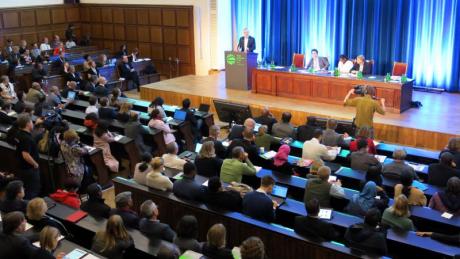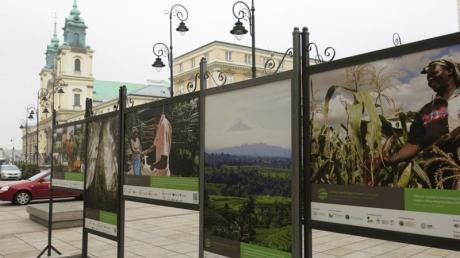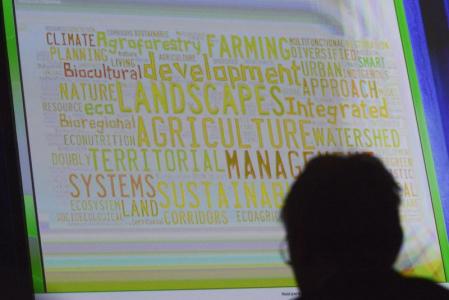“We are two Swedish networks… the research network Focali, focusing on Forest, Climate and Livelihood issues and SIANI, the Swedish International Agricultural Network Initiative…”
“Agriculture you say?” … the man I was talking to stops listening and turns to his colleague “then you should talk with this man instead, he works at the Department of Agriculture, I work at the Department of Natural Resources”…
This scene took place at the joint Focali and SIANI exhibition booth on the second day of the Global Landscape Forum held in Warsaw, 16-17 November 2013 on the sidelines of the UN climate change negotiations, COP19. It was a Sunday so there were no negotiations at COP, and several hundreds of COP delegates joined 1000 participants of the Global Landscape Forum. Numerous visitors passed by our joint booth and stopped for some Swedish confection, a short conversation and to have a look at our publications at display. These two men were country delegates; they had traveled across the globe to attend COP19 and they also came to the Global Landscape Forum.
The conversation I had with them captures in a nutshell why a landscape approach is needed. It also demonstrates that the GLF has the potential to be a cross-sector meeting place and, finally, it points out the necessity that initiatives such as SIANI and Focali deepen their collaboration and inspire others to enhance interactions across sectorial and organizational barriers.

The landscape approach
What does the landscape approach imply, why is it needed and is there really anything new about it? Through some glimpses from the Forum in Warsaw I will shed some light on these questions from my own reflections, messages from sessions I attended and through the views of some experienced colleagues of mine from Focali who were also at the Forum.
First of all, let’s have a look at how the organizers of the Forum describe the problem of disintegrated management of landscapes. Policy recommendations from the Forum state: “There is a long history of segregating landscapes by sector, leading to fragmented and isolated management decisions. As a result we see many examples of unsustainable land use, leading to huge greenhouse gas emissions, loss of ecosystem services and unnecessary risks for livelihoods and food production.”
It is further described how a landscape approach can be used to address the identified challenges: “A landscape approach seeks for better understanding and recognition of the interconnections between different land uses and various stakeholders by integrating them into a joint management process. This provides the opportunity to handle better trade-offs and realize synergies in the landscape.”
However, is this problem and the identified solution a new discovery? Several speakers at the Forum argued that there is nothing new about it; however, the scale of the challenge is escalating. Hence improved collaboration across sectors and disciplines are more urgent than ever.

The big squeeze
At the session “Managing Landscapes for Food, Fuel, Fiber and Forest” the increased pressure on land and natural resources was discussed around the challenge: How do we solve the equation of feeding 9 billion people and still manage to conserve forests and vital ecosystem services within landscapes? The speakers argued that if we don’t manage to produce more with less land, water and less pollution we will experience “the big squeeze” of vital ecosystems and biodiversity. Furthermore, in such circumstances the goal of food security will undermine the efforts of climate mitigation and ecosystem protection. The solution offered to this challenge was sustainable intensification – integrated land-use management combined with modified consumption patterns.
Ruth DeFries, from Columbia University, argued that it is possible to bring together competing interests and manage a multifunctional landscape, but that no single prescription exists for how to do this best. Different contexts demand unique solutions. Additionally, strong policies are needed to handle trade-offs between, for instance, expansion of cultivated areas and efforts to reduce deforestation. Basing on the scale of the challenges ahead of us she stated that “…there isn’t really much choice for scientists and policymakers but to develop the tools and the on- the- ground knowledge for managing landscapes that perform multiple functions. History shows that creative juices start to flow when crisis demands solutions…”
Not a neutral process
I believe that strong incentives for better management of multiple functions in landscapes are necessary and that, to establish such incentives, it is important to talk about the conflicts and barriers on the path to sustainable landscape management. Rachel Kyte, the vice president of Sustainable Development Network at the World Bank, listed different incentives that need to be in place such as, for instance, an increased land tenure security. She also stressed that development and climate change projects only work when people on the ground experience tangible benefits.
Some of my colleagues in Focali also identified the necessity of more critical perspectives. Jenny Friman, PhD candidate at University of Gothenburg, pointed out the need to acknowledge that there are always issues of inequality, gender and power relations that play a role in the way landscapes are managed.

The new hype?
Perhaps, the approach is THE solution. However, without sufficient room for critical reflections of the implications and challenges involved, it might be at risk to become THE new hype. I asked my colleague Susanne von Walter, from the Swedish University of Agricultural Sciences, what does she think about it: “Yes it is the new hype -, she replied, – However, the benefit of this approach is that the land is not separated into ”forests” and ”agricultural land” in real life. Land is used in a holistic way by smallholder farmers. The risk is, however, that the focus will be blurred and that instead of working across sectors as everybody wishes, nobody will feel responsible…”
Another answer to the question was provided by Bruce Campbell, the director of the CGIAR research program on Climate Change, Agriculture and Food Security. He said that “the approach is not new; instead we are finally starting to put our theory in line with the reality and understand the artificial boundaries we have created.”
We consequently have a lot left to learn from reality. If we do, hopefully then adaptation and mitigation will not be put up against each other and forest, agriculture and other land-uses will be more coherently discussed at COPs to come, in national policies and in the formulation of the SDGs. The Global Landscape Forum was in the right place, on the sidelines to COP, and widened the Focali and SIANI network, it deepened our knowledge and gave us a great deal of inspiration. So, I look forward to yet another year where we will be working together to create multi-sector and multidisciplinary meeting places and continue to break down artificial boundaries. “There really is not much choice…” if we are serious about confronting the challenges in front of us.
Currently the project coordinator of Focali (Forest, Climate and Livelihood Research Network) and project coordinator of LARRI (Land Rights Research Initiative) working at GMV – Centre for Environment and Sustainability in Gothenburg. Master degree from School of Global Studies and a B.A in Development and International Cooperation, from University of Gothenburg. Master thesis field research about pastoralists’ livelihoods, socio-ecological resilience, climate change and land investments in the Afar region of Ethiopia. Work experience as a research assistant in research project about the role of trees for local livelihoods, resilience and food-security in Burkina Faso. Work experience as communication officer, lecturer in participatory field methods and as a freelance journalist. Has in addition rich work and study experience related to development cooperation from Ethiopia, Tanzania and Vietnam.